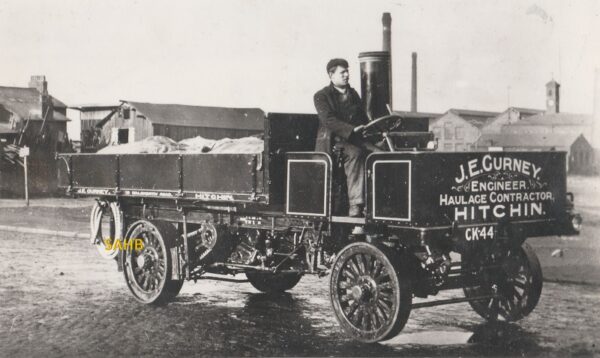
The steam wagon in this Snapshot is difficult to date but, despite being run by J.E. Gurney of Hitchin in Hertfordshire, it has clearly been registered in its town of manufacture: Preston in Lancashire. It could have been built well before the date of 1904 that can be attributed to the very early registration CK 44 that would have been the 44th number given to a vehicle from 1 January 1904 when the law first required such plates.
Coulthard & Co. of Preston was founded in 1815 as a manufacturer of machinery for the cotton industry. The company diversified into other fields: as early as 1896 it became the agent for the Kane-Pennington petrol engine, supposedly used on early motorcycles and motor cars but notorious as a badly designed engine that some even doubt ever worked. In that same year it became part owner of a company set up by James Sumner in Leyland, known as the Lancashire Steam Motor Co., to build steam wagons. That company eventually became Leyland Motors.
Clear signs of the move of T. Coulthard & Co. into the world of powered motor transport came in an article in the Automotor Journal in 1897 reporting on a visit to the factory. However, that report focused entirely upon the manufacture of motor cars with the Kane-Pennington engine, with no mention of steam.
However, a blog on Preston’s own website claims that Coulthards began experimenting with steam lorries in 1895. The need to shovel coal as well as drive was overcome by running the steam engine on oil. In an attempt to increase efficiency, the wagons used triple-expansion compound steam engines, a technology already well developed for ship propulsion. Two pictures in the blog (both taken from Grace’s Guide) show early Coulthard steam lorries from 1897 and 1899. Their basic chain drive systems and spindly iron wheels give definite clues to the vehicle in our Snapshot being later – probably into the 20th century.
Locally built steam lorries were popular with Preston companies. They were used for all kinds of bulk goods including grain shipments from Preston Docks. They were also used over relatively long distances, for example bringing in raw cotton from Liverpool. And, of course, at least one Coulthard steam wagon got as far as Hitchin – although whether on its great competitor the railway or under its own steam we shall never know.
But despite successful use of steam in road haulage right up to World War II with makers such as Sentinel, the writing was on the wall for Coulthard’s use of this motive power as early as 1905, when reports came of a Simms-Coulthard petrol lorry. Steam wagon manufacture passed to the Lancashire Steam Motor Co., from 1907 named Leyland.
Coulthard continued to make textile machinery; it was wound up voluntarily in 1920.







Leave a Comment